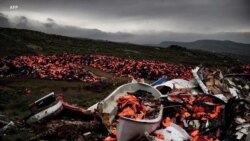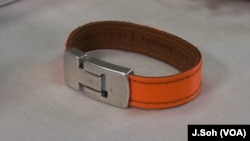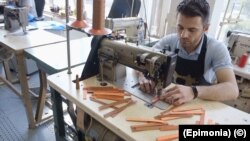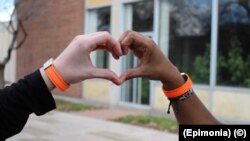If there is an iconic image that sums up the global refugee crisis, it is probably the photograph above of thousands of life jackets strewn on a beach in Greece.
The jackets were worn by desperate refugees crossing the Mediterranean Sea to Europe in unsafe boats.
The first time he saw them, the life jackets stunned Mohamed Malim — and gave him an idea.
Malim was in college last December and starting his own fashion company. His first product was a bracelet, but a bracelet with a set of refugee connections.
WATCH: The Embracelet Embraces Refugees
“This bracelet is made out of recycled life jackets refugees have worn on their journey to safety in Greece,” he told VOA. “As you can see, the outside is the orange life jacket, and the inside is actually the leather embedded [with] our company’s name and our slogan, Building Humanity.”
Half of the proceeds for the bracelet — it sells for $40 — go to nonprofit organizations that help refugees.
Fashion = story
For Malim, now a college graduate, fashion is a tool to tell a story.
“Everyone uses fashion in a way where they basically portray themselves, and they tell a story. I wanted to tell story through my fashion lenses,” he said.
His story is that he is a refugee himself, and he knows how it feels.
“My parents fled from the civil war back in Somalia during the 1990s. I was born in Kenya in a refugee camp,” he said. “When I was 3 years old, we first landed in Texas. I know how to overcome those obstacles in America.”
He named his company Epimonia, a Greek word meaning perseverance. Again, think refugees.
“When refugees flee from civil war or natural disaster, they could go through a lot of hardships during the journey, and they persevere through the journey,” he explained.
Refugee hug
The life jackets are collected on the Greek island of Lesbos and sent to Den Haag, Netherlands, where they are refurbished and cut into bracelets in what Malim calls the Dream Factory.
The Dream Factory, run by Malim’s uncle and business partner, employs refugees.
“By purchasing this bracelet, you are showing your support for the millions of refugees around the world that are currently looking for shelter or protection from danger or distress,” the Epimonia website maintains.
Malim sells the bracelets through college tours, during which he also campaigns to raise awareness of the refugee crisis.
“We need to understand that when refugees flee from war, it’s not their choice,” he said. “When they come to a new country, we need to embrace their culture, the diversity and their talent that they’re bringing in.”
The word “embrace” sums up Malim’s approach to helping refugees, which is why the bracelets are called Embracelets.
By tackling the problem from as many different directions as he can, Malim is opening his arms and giving refugees a big hug.










